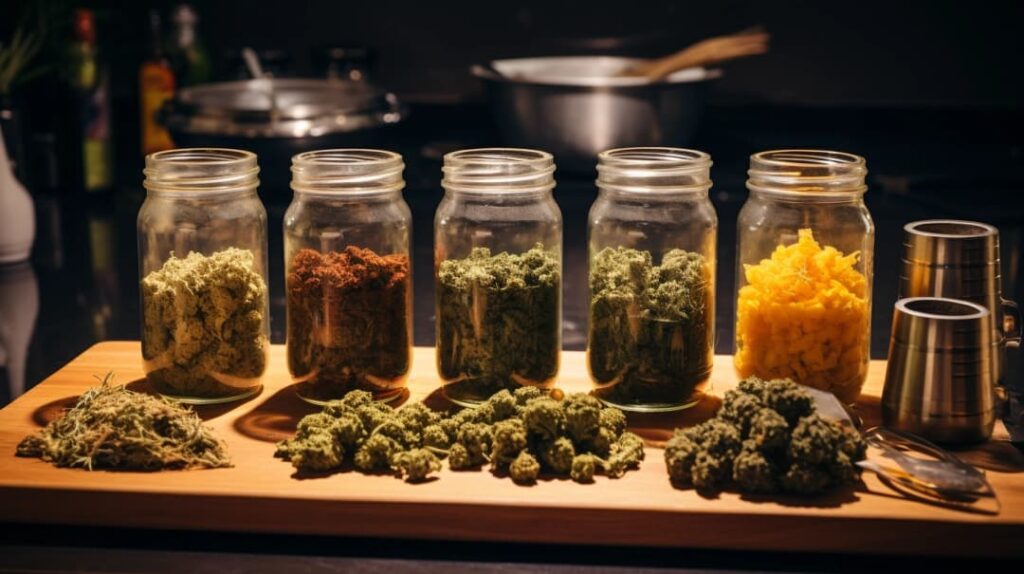Embark on a journey into the art of cannabis infusion methods shaping Denver’s edible products. From classic cannabis edibles to diverse cannabis products, this blog unveils the science behind infusing active compounds. Explore how dispensaries employ their preferred methods to enhance not just flavors but also the health benefits for cannabis consumers.
Understanding the intricate infusion techniques sheds light on the diverse array of edible products available in Denver. Whether you’re a seasoned enthusiast or a health-conscious consumer, this exploration illuminates the dynamic interplay between infusion methods and the final cannabis-infused offerings. It’s time to delve into the heart of Denver’s edible culture, where infusion methods elevate the experience for discerning cannabis consumers, adding depth to their journey.
Decarboxylation Process
To properly activate the cannabinoids in your edible products, you need to understand the importance of the decarboxylation process. Decarboxylation is a crucial step in creating potent and effective edibles. It involves heating cannabis flower or concentrate at a specific temperature for a certain amount of time to convert the non-psychoactive THCA into the psychoactive THC. This conversion occurs because decarboxylation removes a carboxyl group from the THCA molecule, transforming it into THC.
Without decarboxylation, your edibles may not have the desired effects. There are various techniques for decarboxylation, including oven baking, sous vide, and using specialized decarboxylation machines. Each method has its own advantages and considerations, such as temperature control, time efficiency, and odor management. Understanding and mastering decarboxylation techniques is essential for achieving consistent and potent results in your homemade edibles.

Oil-Based Infusion Methods
Now let’s delve into the oil-based infusion methods, which will allow you to effectively incorporate the decarboxylated cannabis into your edible products. When it comes to oil-based infusion, there are a variety of techniques you can use to extract the flavors and cannabinoids from your cannabis. One popular method is the double-boiler technique. This involves heating the oil and cannabis together over low heat for an extended period of time, allowing the cannabinoids to infuse into the oil. Another technique is the crockpot method, where you combine the oil and cannabis in a slow cooker and let it simmer for several hours. Both of these infusion techniques are effective in extracting the desired flavors and cannabinoids from the cannabis, giving your edibles a potent and delicious kick.
Butter-Based Infusion Methods
When it comes to butter-based infusion methods, there are several key points to consider. Firstly, these methods can enhance the flavor profiles of your edible products, adding a rich and creamy taste. Secondly, butter-based infusions offer versatility in recipes, allowing you to incorporate cannabis into a wide range of dishes. Lastly, these methods provide consistency in dosing, ensuring that each serving contains the desired amount of cannabinoids.
Enhanced Flavor Profiles
With butter as the base, you can enhance the flavor profiles of Denver’s edible products through various infusion methods. Culinary creativity plays a vital role in achieving unique and delicious taste enhancements. By infusing butter with different herbs, spices, or other flavoring agents, you can elevate the taste of your homemade edibles to new heights. The infusion process involves slowly heating the butter and adding your chosen ingredients to extract their flavors.
This allows the butter to absorb the aromatic compounds, resulting in a rich and flavorful base for your recipes. Whether you’re making cannabis-infused baked goods or savory dishes, butter-based infusion methods offer endless possibilities to tailor the taste of your edibles to your liking. So get creative and experiment with different flavors to create an elevated culinary experience.
Versatility in Recipes
Enhance the versatility of your recipes with butter-based infusion methods. Butter is a versatile ingredient that can be infused with various flavors to elevate your dishes to new heights. Not only does it add richness and depth, but it also allows for easy incorporation into a wide range of recipes.
Whether you’re looking to adapt to dietary restrictions or simply experiment with different infusion techniques in savory dishes, butter is the perfect vehicle for infusing cannabis. From infused garlic butter for savory breads to infused herb butter for roasted meats, the possibilities are endless. With butter-based infusion methods, you can create delicious and infused dishes that cater to everyone’s tastes and preferences. So go ahead, get creative in the kitchen and explore the incredible versatility of butter-based infusions.
Consistency in Dosing
Looking to ensure consistent dosing in your infused dishes? When it comes to butter-based infusion methods, precision dosing and standardized measurements are key. Here are three ways to achieve consistency in your infused recipes:
- Precise Measurement: Use a kitchen scale to accurately measure the amount of cannabis you’re adding to your butter. This will help you maintain a consistent potency throughout your dishes.
Infusion Time: Determine the optimal infusion time for your desired potency. Keep track of the time to ensure that each batch of infused butter is infused for the same duration, resulting in consistent dosing. - Recipe Adjustments: Adjust the amount of infused butter used in your recipes to achieve the desired effect. By using standardized measurements, you can ensure that each serving contains the same amount of cannabinoids.

Alcohol-Based Infusion Methods
To infuse edibles with alcohol, you can use various methods in Denver’s edible products. When it comes to alcohol-based infusion, one important factor to consider is the alcohol potency. Different types of alcohol have different alcohol content, and this will affect the potency of the infused edible. For example, using a high-proof alcohol like Everclear will result in a more potent infusion compared to using a lower-proof alcohol like vodka.
Another factor to consider is the infusion time. The longer you let the edible sit in the alcohol, the stronger the infusion will be. However, it’s important to note that there is a point of diminishing returns, where the flavor of the alcohol becomes overpowering. So, it’s important to experiment and find the right balance of infusion time to achieve the desired potency without sacrificing taste.
Water-Based Infusion Methods
When infusing edibles with water, there are several methods you can use in Denver’s edible products. Here are three flavor infusion techniques to consider:
- Sous vide: This method involves vacuum-sealing the ingredients with water and cooking them at a precise temperature for a prolonged period. The low and slow cooking process allows the flavors to infuse into the water, resulting in a more intense and balanced taste.
Infused syrups: By simmering herbs, fruits, or spices in water, you can create flavorful syrups that can be used in various edible products. These syrups not only add taste but also enhance the overall mouthfeel of the product. - Cold infusion: This technique involves steeping ingredients in cold water for an extended period. Cold infusion is particularly useful for delicate flavors that can be lost with heat. It creates a refreshing and subtle taste profile in the final product.
Water-based infusions offer several benefits, including a cleaner and more natural taste, as well as the ability to control the intensity of flavor. Additionally, they are a healthier alternative compared to alcohol-based infusions, making them a popular choice among health-conscious consumers.
Solvent-Based Infusion Methods
For a different approach to infusing edibles in Denver’s edible products, you can explore solvent-based infusion methods. These methods involve using solvent extraction to infuse cannabinoids into various food products. Solvent extraction is a process where a solvent, such as ethanol or butane, is used to dissolve the cannabinoids from the cannabis plant material. This allows for a highly efficient extraction of the cannabinoids, resulting in a potent infusion. Once the cannabinoids are extracted, they can be added to a wide range of edible products, including chocolates, gummies, and baked goods. Solvent-based infusion techniques offer a versatile and effective way to infuse edibles with cannabinoids, ensuring a consistent and potent experience for consumers.
Final Thoughts
Overall, Denver’s edible product industry offers a variety of infusion methods to create cannabis-infused products. From decarboxylation processes to oil, butter, alcohol, water, and solvent-based methods, there are numerous options available for consumers. These infusion methods allow for the incorporation of THC and CBD into edible products, providing a range of choices for individuals seeking alternative methods of cannabis consumption in Denver.


